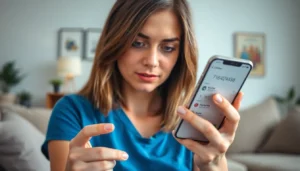Table of Contents
ToggleIn a world overflowing with gadgets and apps, minimalism offers a refreshing approach to technology. For those seeking simplicity, tech for minimalists focuses on essential tools that enhance life without the clutter. This philosophy champions quality over quantity, allowing individuals to embrace functionality and purpose in their digital experiences.
Imagine a lifestyle where every device serves a specific need, cutting out distractions and unnecessary complexities. From streamlined smartphones to versatile smart home devices, minimalist tech empowers users to focus on what truly matters. By prioritizing efficiency and ease of use, they can cultivate a more intentional and fulfilling relationship with technology.
Overview of Tech for Minimalists
Tech for minimalists emphasizes essential devices and applications that support a streamlined lifestyle. Minimalist technology reduces distractions, prevents overwhelm, and encourages users to prioritize functionality and simplicity.
Key components of minimalist tech include:
- Smartphones: Devices that combine multiple functions, allowing users to communicate, manage tasks, and access information seamlessly. Brands like Apple and Google offer options with essential features without unnecessary bloat.
- Laptops: Lightweight, versatile machines serve as the main computing device, enabling work, entertainment, and communication in one compact form. Models such as the MacBook Air and Dell XPS emphasize portability and performance.
- Smart Home Devices: Tools that automate everyday tasks, such as smart speakers and thermostat systems, streamline home management. Devices like Amazon Echo and Nest Learning Thermostat provide convenience without the need for excessive gadgets.
- Digital Note-Taking Apps: Applications like Notion or Evernote simplify organization, allowing users to capture ideas, plan tasks, and maintain clarity without physical clutter. These tools enhance efficiency by centralizing notes and documents.
- Wearables: Fitness trackers and smartwatches monitor health metrics and notifications without the need for cumbersome devices. Products like the Fitbit and Apple Watch enable users to stay informed while minimizing the amount of technology they carry.
Selecting the right tools enhances minimalist living, allowing users to focus on their goals and experiences. Embracing tech for minimalists fosters an intentional relationship with technology that promotes clarity and purpose.
Essential Gadgets for a Minimalist Lifestyle

Minimalists prioritize gadgets that enhance functionality while reducing clutter. Essential tools serve specific purposes, simplifying everyday tasks.
Smartphones with Simple Interfaces
Smartphones featuring simple interfaces streamline daily interactions. Devices such as the Google Pixel series or Apple’s iPhone SE offer user-friendly designs, focusing on key functions without unnecessary complexity. These smartphones come with essential apps for communication, navigation, and productivity, eliminating distractions from excess features. Optimized battery life and camera capabilities ensure a satisfying user experience while promoting efficiency.
Multi-Functional Devices
Multi-functional devices minimize the need for multiple gadgets. For example, laptops like the MacBook Air or the Microsoft Surface Pro combine computing, tablet, and drawing capabilities. Additionally, smart speakers such as the Amazon Echo or Google Nest not only play music but also control smart home devices and provide information on demand. By reducing the number of devices, minimalists save space and simplify their technology ecosystems, ultimately enhancing their digital experience.
Software and Apps for Streamlined Living
Minimalist technology extends into software and apps that promote streamlined living. By utilizing specific tools, users can enhance productivity and maintain a clutter-free digital space.
Productivity Tools
Productivity tools cater to minimalist needs, focusing on task completion without distraction. Notable options include:
- Todoist: A task management app that organizes to-do lists efficiently, featuring labels, filters, and priorities for streamlined task tracking.
- Trello: A visual project management tool that uses boards and cards to simplify collaboration and organization, ideal for both personal and professional projects.
- Notion: An all-in-one workspace that combines notes, tasks, and databases, allowing users to customize their digital organization system without excess.
- Evernote: A note-taking app that stores and organizes information, enabling easy access and management of ideas and projects.
- Focus@Will: A music service designed to boost productivity by offering curated playlists that enhance focus and minimize distractions.
Minimalist Design Apps
Minimalist design apps emphasize simplicity and functionality in both aesthetics and user experience. Leading options in this category include:
- Canva: An intuitive graphic design platform offering templates that help create visuals without unnecessary complexity or steep learning curves.
- Figma: A collaborative design tool that facilitates streamlined design workflows, allowing multiple users to contribute in real time.
- Adobe Spark: A simplified version of Adobe’s design software that enables users to create stunning graphics, web pages, and videos quickly and easily.
- Milanote: A flexible tool for visual organization, perfect for brainstorming and planning projects with a clean and uncluttered interface.
- Airtable: A hybrid of a database and spreadsheet, Airtable’s clean design allows for efficient organization of information, making project management simple.
By integrating these software tools and apps into daily routines, users can cultivate a more focused and purposeful digital environment, reinforcing their minimalist lifestyle.
Benefits of Embracing Minimalist Tech
Embracing minimalist tech offers several significant benefits that align with a streamlined lifestyle.
- Reduced Clutter: Minimalist tech reduces both physical and digital clutter, creating more space for essential items. Users can focus on fewer devices and applications, leading to a more organized environment.
- Enhanced Productivity: With fewer distractions, individuals can concentrate better on tasks. Simple interfaces and multi-functional devices allow for quicker access to needed features, thereby increasing efficiency.
- Greater Clarity: Minimalist tech promotes clarity in decision-making. Clearly defined functionalities of each device minimize confusion, allowing users to navigate their digital lives more effectively.
- Sustainability: Opting for high-quality, long-lasting devices reduces electronic waste. Minimalists often choose products that serve multiple purposes, which supports eco-friendly practices and sustainable consumption.
- Intentional Usage: Minimalist tech fosters a more intentional approach to technology use. The careful selection of tools encourages users to engage meaningfully with their devices while prioritizing their personal and professional goals.
- Improved Well-Being: A simplified tech ecosystem leads to reduced stress and increased mental well-being. Users often report greater satisfaction and less overwhelm as a result of their focused digital experiences.
- Cost Savings: Investing in fewer, high-quality devices often results in decreased expenses over time. With minimal tech, users avoid unnecessary subscriptions and updates associated with multiple devices.
Utilizing minimalist tech enhances life quality by promoting efficiency, clarity, and intentionality. This approach aligns perfectly with a lifestyle committed to simplicity and purpose.
Challenges of Minimalist Technology
Minimalist technology poses several challenges that users must navigate to achieve simplicity.
Overcoming Attachment to Gadgets
Users often face difficulty in letting go of devices, even those that no longer serve a purpose. Emotional attachments to gadgets can hinder the transition to a minimalist tech lifestyle.
Balancing Functionality and Simplicity
Finding devices that maintain high functionality while being simple can prove challenging. Some gadgets may appear minimalist but lack essential features, leading to frustration.
Managing Digital Clutter
Despite minimizing physical devices, users can struggle with digital clutter. Files, applications, and notifications can accumulate, countering efforts to create a streamlined digital environment.
Adapting to New Devices
Switching to fewer gadgets often requires learning new interfaces or functionalities. Users may experience temporary disruptions as they adapt to new technology.
Maintaining Connectivity
Minimalist tech can hamper connectivity options. Some users find fewer devices limit their ability to communicate, manage tasks, or access information efficiently.
Budget Considerations
Investing in quality minimalist technology may entail higher upfront costs. Users sometimes hesitate to allocate funds towards premium devices when they have existing, but unnecessary, options.
Avoiding Over-Optimization
Users may fall into the trap of constantly seeking the best minimalist solutions. This pursuit can become overwhelming, detracting from the intended benefits of simplicity.
These challenges highlight the importance of a thoughtful approach when embracing minimalist technology, ensuring users can enjoy its benefits without succumbing to common pitfalls.
Embracing minimalist technology offers a pathway to a more intentional and fulfilling digital life. By focusing on essential tools that serve specific purposes, individuals can reduce distractions and enhance productivity. The right combination of devices and software fosters clarity and simplicity while supporting personal goals.
Navigating the challenges of minimalist tech requires a thoughtful approach. It’s about finding balance and prioritizing quality over quantity. As users adopt this lifestyle, they not only declutter their physical spaces but also cultivate a more purposeful relationship with technology. Ultimately, minimalist tech empowers individuals to thrive in a complex world while enjoying the benefits of simplicity and efficiency.







